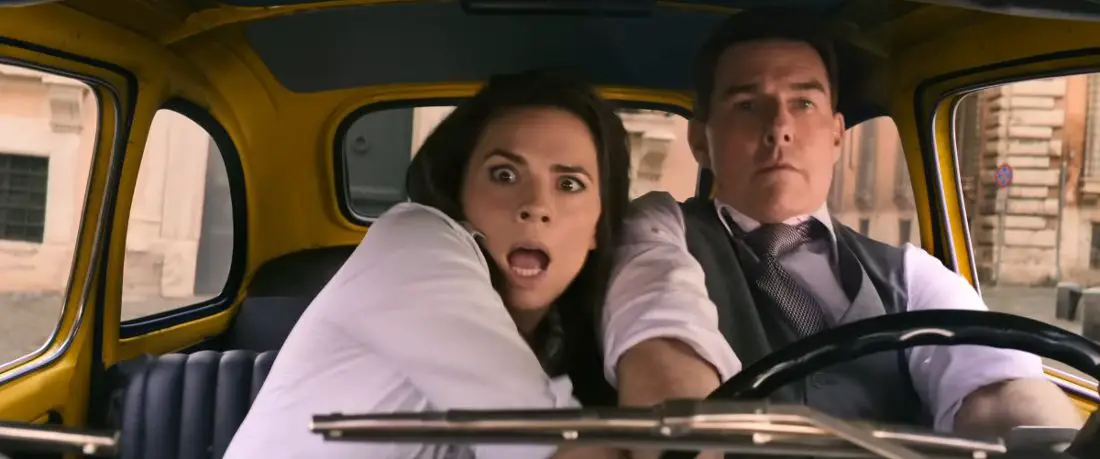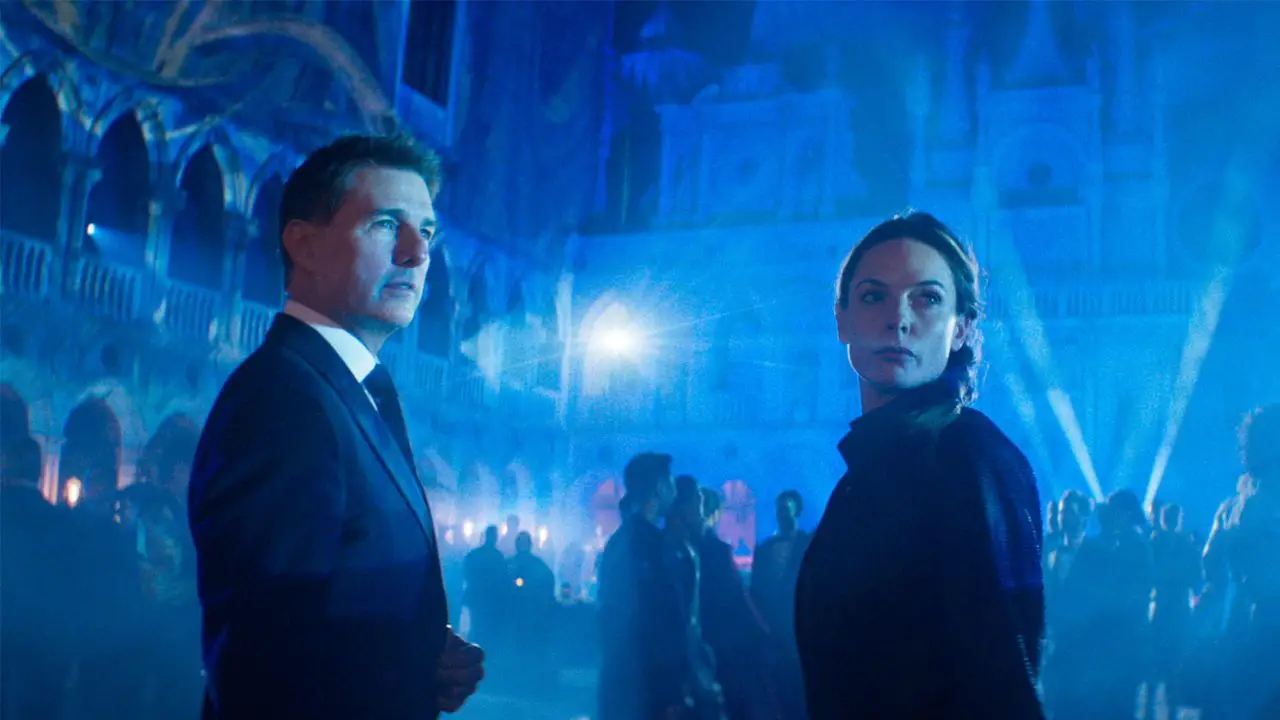I was nodding off within the first five minutes of the latest Christopher McQuarrie spectacle, Mission: Impossible-Dead Reckoning Part One. But in all fairness, I had been up since five am, so finding myself in a recliner in a dark room was only inevitable. However, soon, I was under the movie’s spell, and I found my exhaustion vanishing as I clapped at the action and laughed at the audacious Buster Keaton-esque set pieces.
In his way, McQuarrie has made the Mission Impossible movies’ big screen television events the same as most modern blockbusters- with one exception: he injects a theatricality, a playfulness, and a staggering cinematic sense that keeps the films from being pedestrian. When I say big-screen television, I mean old-school television, the disposable kind meant to kill some time, excite you, and then roll credits. Mission Impossible movies have opening credits, much like a show, with the familiar theme song, showing us the cast and some scenes from the upcoming episode, all to remind you of the familiar and to whet your appetite for the forthcoming show.

The movie has such showmanship and razzmatazz that it embraces its television roots while also moving forward and refusing to be chained by them. Dead Reckoning Part One is a roaring globe-trotting romp, as these movies usually are, with outrageous scenarios that defy reason, physics, and common sense but leave us hooting and hollering. McQuarrie and his DP Fraser Taggart make every frame visually dynamic. Even in conversations where characters are embroiled in esoteric double talk, Taggart’s camera and McQuarrie’s staging are such that you can’t take your eyes off the screen.
Of course, that could also be because McQuarrie has stacked his cast with some of the most watchable faces I’ve seen in a while. Of course, there’s Tom Cruise, Ving Rhames, and Simon Pegg as Ethan Hunt, Luther, and Benji, respectively. But toss in Rebecca Ferguson, Vanesa Kirby, Pom Kelmentiff, Shea Whigham, and Esai Morales, and you have a return to the cinema of faces. Taggart’s camera also understands Josef von Sternberg’s belief in lighting, in that it can turn anyone into a movie star and captures the hypnotic beauty of all the leads, making them both compelling, mysterious, and oh-so alluring.
The film’s biggest coup d’etat is not the latest Tom Crusie action set piece in which he proves he again is the American answer to Jackie, Chan-though it is jaw-dropping, and he is. It is instead the about-damn-time realization of the talents of Hayley Atwell. To say that she and Cruise’s chemistry sparks almost instantly is an understatement; I’d argue that, at times, she almost outclasses him, stealing scenes and nearly the entire movie.
I will never-and have never-forgiven the MCU for such a clumsy fumbling of Atwell’s talents. Happily, McQuarrie and Taggart recognize that Disney’s nearsightedness is their secret spice to injecting life into a franchise that finds new ways to get that extra jolt with every installment. Atwell and Cruise have a car chase scene that had me chuckling and gasping as Taggart, who lensed John Wick: Chapter 2, finds ways to make the idea of a car chase scene feel new while also familiar. It’s a patch on the climatic train scene. Still, both have a thoughtfulness and a wry sense of humor that calls back to the early silent days of Buster Keaton’s “impossible gags,” a sensibility that tends to work spectacularly for espionage action movies.
McQuarrie and Erik Jendersen’s script is the right amount of nonsense implausibility and commentary on our all too interesting times, especially regarding AI. The plot to the Mission: Impossible movies run together for me, but I appreciate that there’s always just enough tether to the day’s events that gives them a sort of immediacy. I won’t bore you with the details except that Ethan Hunt must again go rogue to save the world. Something that’s happened so often that Dead Reckoning even has a fun conversation poking fun at it.
But the thing that makes the script for Dead Reckoning pump, where others merely peddle, is the earnestness. Ethan Hunt cares, and the movie never mocks him for it. When Ethan tells a character that he, no matter what will be on that train, it’s not meant as a joke. It’s intended as a solemn vow. It’s not afraid to care, or what’s more, have its characters care.

Indeed, one of the more fascinating aspects of Dead Reckoning is how it explores Ethan’s propensity for mercy. A man who bristles at the notion of “for the greater good” also believes in “the greater good.” At one point, he spares a character’s life, a simple act that baffles said character and imbues their final scene with a sense of emotional tragedy and tenderness that would come off as trite in another movie.
But back to Hayley Atwell. Gosh, she’s great. Her Grace is a delightful agent of chaos, a lovely counterbalance to the no-nonsense Ethan. An orphan pickpocket straight out of Dickens, she’s a perfect fit for Ethan’s rag-tag team of misfits. Atwell plays Grace with a sense of cockiness and hesitancy, she likes a good time, but when entire nations are after you, it’s a little much. She has a wit and a vulnerability about her that draws you in and leaves you chuckling when you realize she’s handcuffed Ethan to the steering wheel.
If nothing else, you must love a movie that understands they’ve never come up with a better character name than Ilsa Faust (Rebecca Ferguson) and take every opportunity to say her full name as dramatically as possible. And if there’s one thing McQuarrie and the MI franchise are great at, it’s being overly dramatic in the most delightful, full-throated, cackling way. The opening alone, the scene where the head of the NSA, played by the great Cary Elwes, is told about the IMF, had me clapping and giggling at the ostentatiousness of it all.
This scene, along with all the others, works not just because of McQuarrie’s staging, the actor’s dialogue, and Taggart’s brilliant lighting and framing but Eddie Hamilton’s editing. Dead Reckoning is edited with rapacious joy, every cut and transition adding to the delicious spectacle. The way the filmmakers will edit a conversation close-ups of the actor’s faces, either from the side or full-on, adds heft to the visual style and tension to the moment.
And then, to top it all off, Shea Whigham is in this thing? I mean, come on!

I haven’t even mentioned how Dead Reckoning has one of my favorite villain tropes where the bad guy, the mysterious Gabriel (Esai Morales), finds out Ethan has tricked him causing him to cry out his name, all but shaking his fist at the air. It’s cinema is what it is.
Hanging over everything is the dread of the Entity, the self-learning, self-evolving algorithm that threatens to upend the political power structure of the world and possibly human existence. I mean, there are stakes, and then there are STAKES. Whether by coincidence or intentionally, it’s an acknowledgment of the industry’s real fear and uncertainty about the emergence of AI tech and the ramifications of what it means for the future.
Anyway, Mission: Impossible-Dead Reckoning Part 1 does what it always does: absorb modern trends into its DNA and improve on it.
But I digress, back to Hayley Atwell. She’s not the star, but I wouldn’t mind it if she were.
Images courtesy of Paramount Pictures
Have strong thoughts about this piece you need to share? Or maybe there’s something else on your mind you’re wanting to talk about with fellow Fandomentals? Head on over to our Community server to join in the conversation!

